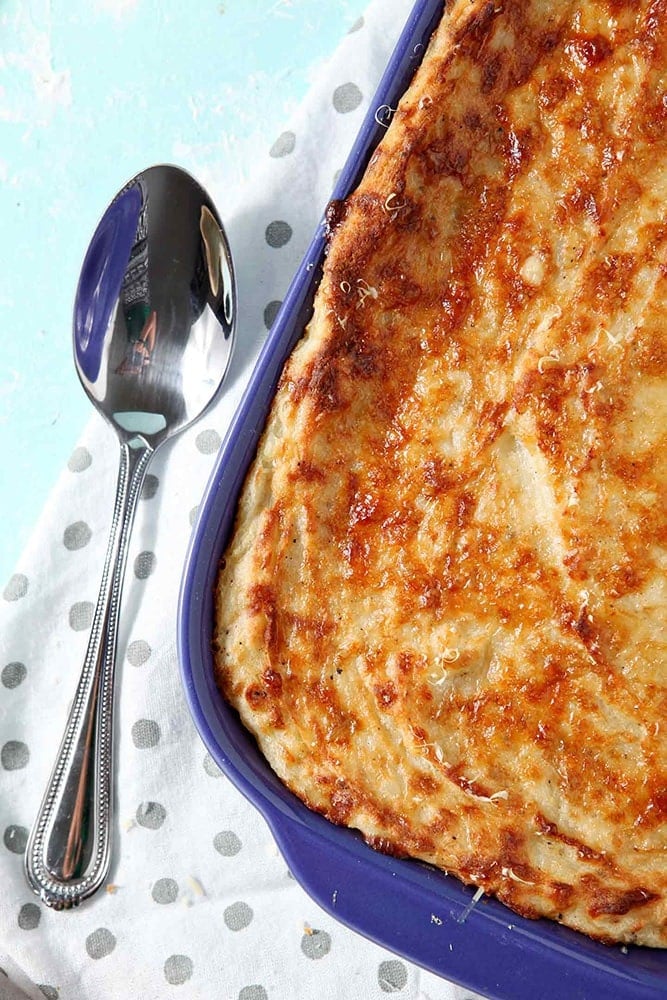Discover the latest and greatest recipes trending for ‘thanksgiving recipes’. We’ve curated a selection of mouthwatering dishes that are sure to impress your family and friends.
1. Garlic Parmesan Mashed Potato Casserole
The first thing that jumps out at me is the whole garlic cloves. It’s an interesting choice that’ll give this casserole a deep, roasted garlic flavor. I love that they’re not mincing or pressing the garlic, which allows for a more mellow, caramelized taste once baked.
The potato-to-liquid ratio also catches my eye. With 3 pounds of potatoes and only a cup of milk, these mashed potatoes are going to be on the denser side. That’s perfect for a casserole, as it’ll hold its shape well when served. The addition of Parmesan cheese (which I assume is added later in the recipe) will also contribute to a firmer texture. It’s a smart move for a dish that’s meant to be sliced and plated.
For more details and tips, check out the original recipe.
2. Pumpkin Cheesecake
Ah, pumpkin cheesecake – a classic fall dessert! I’d start with the crust, as it’s the foundation of any good cheesecake. Those gingersnaps will give a nice spicy kick that complements the pumpkin beautifully. Make sure to crush them finely for the best texture. I like to use a food processor, but you could also put them in a bag and go to town with a rolling pin if you need to work out some stress!
For the filling, quality canned pumpkin is key. Libby’s is a solid choice, but don’t be afraid to try other brands or even roast your own pumpkin if you’re feeling ambitious. The sugar amount seems spot on – you want it sweet, but not cloying. I might add a touch of cinnamon or nutmeg to really bring out those warm, autumnal flavors. And don’t forget a water bath when baking – it’s crucial for that perfectly smooth, crack-free top.
For more details and tips, check out the original recipe.
3. Bacon Wrapped Turkey with Maple Sage
The standout technique in this recipe is the bacon-wrapping method. It’s a clever way to add flavor and keep the turkey moist during cooking. Laying strips of bacon over the bird creates a protective layer that bastes the meat as it cooks, infusing it with smoky goodness. This approach also helps achieve that coveted crispy skin without drying out the turkey underneath.
I’m intrigued by the combination of maple and sage with the bacon. It’s an interesting twist on the classic herb-roasted turkey, bringing in some sweetness to balance the savory elements. When working with these flavors, I’d recommend brushing the bacon with a bit of maple syrup towards the end of cooking. This will create a delectable glaze and really amplify that maple flavor. Just be careful not to add it too early, or you’ll risk burning the bacon.
For more details and tips, check out the original recipe.
4. Cranberry Pecan Quinoa Stuffed Acorn Squash
Ah, cranberry pecan quinoa stuffed acorn squash – what a fantastic autumn dish! For a novice cook, the trickiest part might be handling the acorn squash. These little gourds can be stubborn to cut, so make sure you’ve got a sharp, sturdy knife and a steady hand. Don’t rush it, and remember to scoop out those seeds thoroughly.
Another potential challenge could be cooking the quinoa just right. It’s easy to end up with mushy or undercooked quinoa if you’re not careful. My advice? Keep a close eye on it and taste test as you go. Oh, and don’t forget to rinse the quinoa before cooking – it can have a bitter coating that’s best washed away. As for the stuffing, balancing those cranberry and pecan flavors with the quinoa might take a bit of practice, but trust your taste buds and you’ll nail it.
For more details and tips, check out the original recipe.
5. Pumpkin Cheesecake
Ah, pumpkin cheesecake – a classic fall dessert that’s always a crowd-pleaser. One key skill for nailing this recipe is getting that gingersnap crust just right. It’s the foundation of the whole dish, after all.
To practice, I’d suggest this simple exercise: Take a handful of gingersnaps and crush them by hand in a bowl. Then try using a food processor. Compare the texture and consistency between the two methods. You’re aiming for fine, even crumbs that’ll hold together when mixed with melted butter. This will give you a feel for the ideal texture and help you avoid an overly chunky or powdery crust.
Another crucial element here is balancing the pumpkin and sugar. Too much sugar can overpower the subtle pumpkin flavor. Try this: Mix a small amount of canned pumpkin with varying amounts of sugar, tasting as you go. This will help train your palate to recognize the sweet spot where the pumpkin shines through without being cloying. It’s a skill that’ll serve you well beyond just this recipe.
For more details and tips, check out the original recipe.




